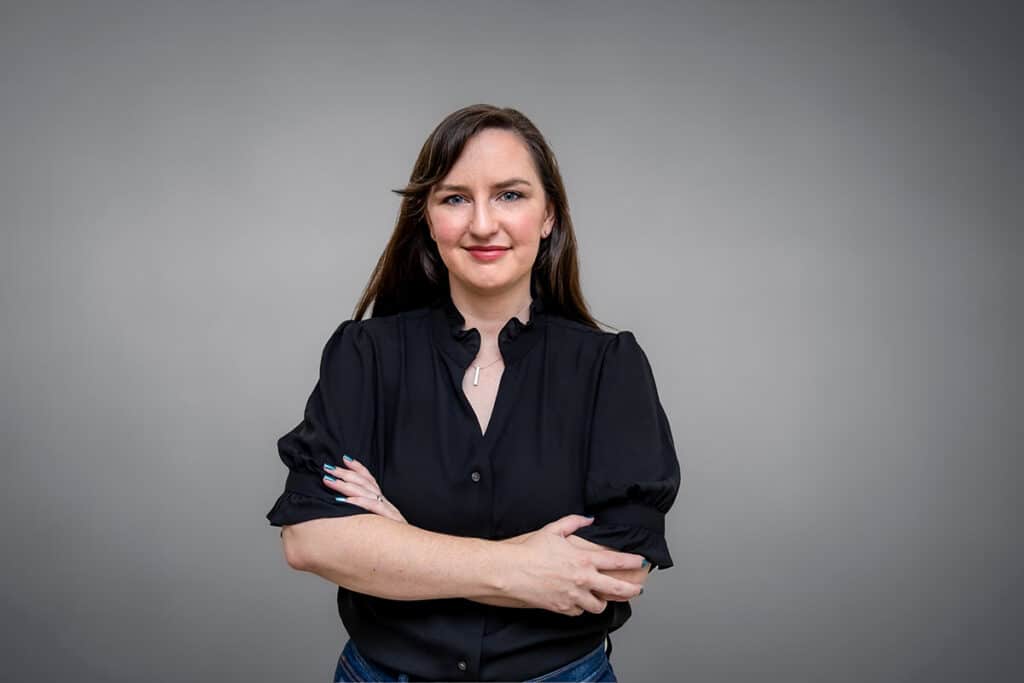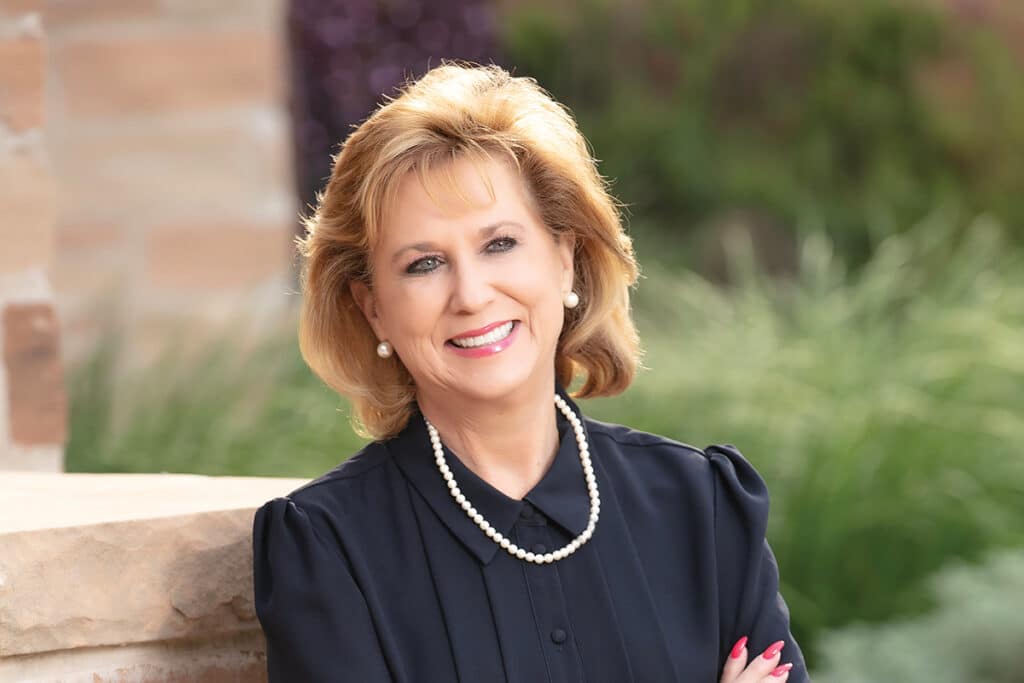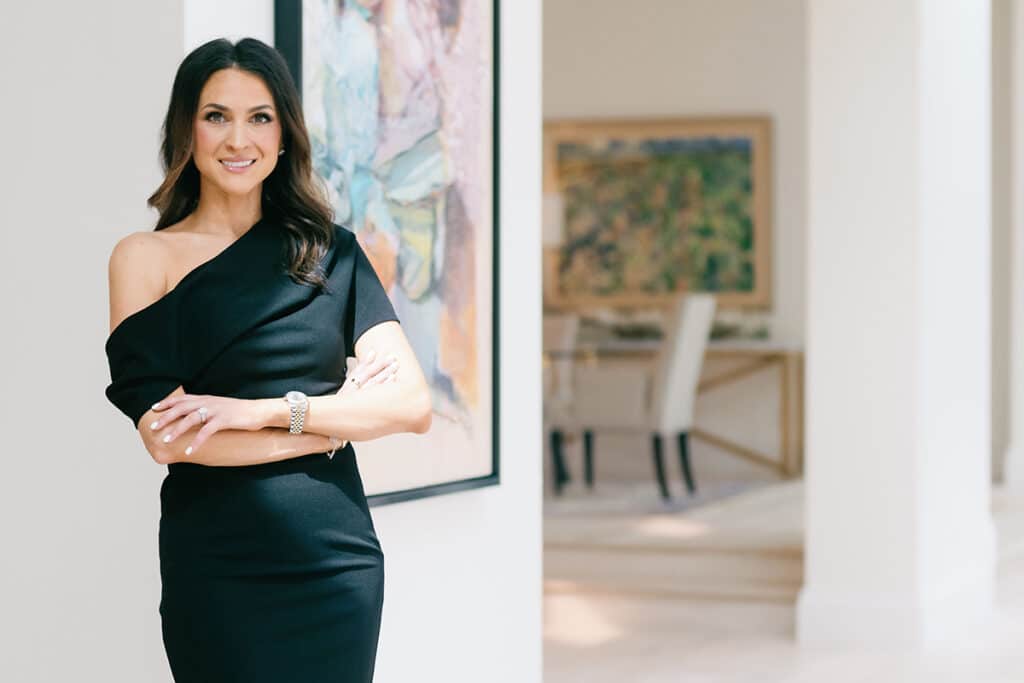A love of animals draws many women to the field of veterinary medicine. After all, compassion and intuition — two traits women are believed to have in abundance — have strong currency in the animal kingdom.
Surprisingly, women in Texas entered veterinary medicine decades later than they penetrated other male-dominated professions. Texas A&M University houses the only veterinary college in the state, and the university did not accept women students until 1963. The first woman to become a licensed vet in Texas received her degree in 1966. Today, about 70 percent of Texas A&M’s veterinary students are women. Here, you’ll meet several women who answered a call to care for animals.
Laurie Sweet Richardson, DVM
Oaks North Animal Hospital
As a young girl, Laurie Sweet Richardson loved science, so when she started college, studying medicine had a natural allure. While she was in school, she narrowed her interests to animals.
After she received her doctorate in veterinary medicine from Texas A&M, she spent her first four years working for someone else. Then it was make-or-break time. Richardson and her husband, Pat, who is also a vet, decided to go out on their own. Today, Richardson’s clinic — Oaks North Animal Hospital — has been a fixture at a busy northwest-side intersection for 22 years. Her husband owns a separate practice in another part of the city.
Richardson’s solo practice focuses on companion animals — cats and dogs — and what she calls “pocket pets” — rabbits, guinea pigs, hamsters and the like. “I like veterinary medicine because I get the combination that you don’t have in other areas of medicine. My day is a mix of routine exams, diagnostics and surgeries,” she says.
Another aspect of veterinary medicine is that the doctor is not just treating the patient. The pet’s owner plays a key role in the relationship. “Communication is key with clients,” Richardson says. “My job is to advocate for the animal; but the animal can’t talk to us, so that makes it hard to know what’s wrong sometimes. Talking with the pet’s owner is how I get most of the information I need.”
Keeping a pet requires learning about that animal’s tendencies and needs. “Sometimes that means I have to educate pet owners so that we can all provide appropriate care,” Richardson explains. In other instances, listening to the pet’s owner provides valuable insight. “Owners can be very perceptive — they often pick up on things before I do,” she says.
Advancing technology in veterinary medicine means that animals often get the same exams and treatments people do. Just a few years ago, ordering an ultrasound for an animal was virtually unheard of; it’s routine today, and it helps identify problems vets could only guess at before. Animals are living longer, healthier lives, but it comes at a cost, and that cost is rising in pace with technology.
Some clients will cover the bills, no matter the cost, while others have limited means or are unwilling to put that sort of investment into an animal. Richardson sees the spectrum in her practice but says that most health care decisions — no matter the outcome — aren’t made lightly. “Sometimes we can make it better, sometimes we can’t,” she says.
She adds that the advent of pet insurance has changed the picture somewhat. “The insurance companies are moving slowly, trying to get it right,” she says. Her advice to people considering pet insurance: “Weigh the cost of the insurance against what you’re spending in a year. If you get a policy when the pet is young, it can pay off in the long run, since older pets typically need more care.”
Richardson says her motivator is the relationships she’s built with pets and their owners. “Seeing the animal and the owner over a period of time helps me understand the environment the animal is in every day and gives me insight as to how I should advise the owner,” she says.
A challenge for Richardson is the ongoing business needs of her practice. From finding and keeping good employees, to managing expenses and keeping up with legal and regulatory issues, she says it’s understandable why some vets “go corporate,” taking jobs with national franchise operations, usually connected with pet retailers. She points out, “The business structure is there. You lose some control, but it can remove some pressures.” Challenges aside, Richardson says she’s happy to be on her own. “I have flexibility as a business owner — I can schedule my life, and I can be where my kids need me.”
Richardson looks for — and usually finds — satisfaction in the day-to-day events in her practice. “My work is extremely rewarding,” she says. “I’m humbled by the trust my clients place in me and how much they care about us.”
Sherri Youngblood, DVM
Spring Creek Animal Hospital
Sherri Youngblood grew up amongst dogs, cats, goats, horses and chickens at her parents’ Hill Country Village home. She remembers wanting to be a vet when she was 5 years old. “That was my fork in the road,” she says. “I never wanted to do anything else.”
Youngblood had a particularly deep love of horses and thought she’d be an equine vet. She even took her horse with her when she left for school. She changed her mind during her senior year.
Deciding to be a small animal vet didn’t mean she was forsaking horses; in fact, Youngblood and her family — husband, Jim; daughter, Rachel, 13; and son, John, 11 — now raise, breed and show Arabian horses.
“Equine care is a lot of shots, de-worming, things like that — you can only do so much in the field,” she explains. She found greater challenge in the diversity that caring for small animals offered. Youngblood worked in an established veterinary practice right out of school. Her passion for work was so great that her husband finally made a suggestion: “You’re working like you own the practice,” she recalls his saying. “If you’re going to work this hard, why don’t you work for yourself?”
Youngblood was content to stay put, and a little intimidated by the idea of striking out on her own. “It’s a very big commitment to start a business,” she says. “There’s no way I would have gone out on my own if it hadn’t been for my family.”
Youngblood opened Spring Creek Animal Hospital in 2000. She and her husband designed the facility from scratch. “We toured a lot of facilities and learned what we liked and what we didn’t like,” she says. The result is a freestanding 7,500-square-foot facility. “We offer dental care, X-rays and other diagnostics; I can perform surgery; I can do it all right here,” she says.
Youngblood is the only vet on staff; she relies on the services of “relief vets” when she can’t be at the clinic and her staff of receptionists, technicians and kennel personnel to keep things running smoothly.
“You have to be passionate about this work and about animals,” Youngblood says. “It’s seven years of school and a lot of hard work for relatively little pay, compared to other professions.”
She’s surprised by the number of people who don’t realize the amount of education required of veterinarians. “One of my clients didn’t think being a vet required an education,” she laughs. “Our education is ongoing. We have to do continuing education to be able to practice.”
Until earlier this year, Youngblood served on the city’s Animal Care Services Advisory Board. It was a tough job during difficult times, with a lot of public attention focused on the operating standards of local animal control facilities. She stepped down when her term expired, but says she’s eager to become eligible for another board term. “It’s my community service,” she says. “I’m glad to do it.”
Youngblood’s daughter wants to be a vet, a declaration Youngblood considers a testament to her work. She’s supportive but makes sure her daughter understands the realities of the profession: “I tell her not to do it for the money. I make a good living, but it’s taken me 16 years to get where I am, and I’m still working six days a week.”
She describes herself as self motivated. “I’ve always been a high achiever. This isn’t just a job for me,” she says. “Passion drives me, and so do my client and patient relationships. I have a great balance to my life. All I can do is my best. Nobody can ask more than that. I learn every day.”
Tracy S. Tommack, DVM
Traveling Tails
When she graduated from veterinary school, Tracy Tommack saw a gap and decided to fill it. Today, Traveling Tails, the mobile veterinary service she started in 2002, takes Tommack to her patients in a 26-foot recreational vehicle that she converted to a fully equipped animal hospital. “Austin and Dallas have mobile vets, but San Antonio didn’t have one,” she says. “I saw a need and filled it.”
The RV houses two exam tables; one converts to a surgical table, and the second doubles as a “wet” table for dental procedures. There’s also an X-ray machine, a microscope and blood chemistry machine, as well as a fully stocked pharmacy. About the only thing Tommack says she doesn’t do in the RV is board and bathe animals.
“The great thing about the mobile clinic is we are able to provide all of these services at the convenience of our clients and their pets,” says Tommack. “It’s popular with families who have trouble getting to the vet. Some animals just don’t travel well,” she explains. The mobile clinic has attracted owners of large breed dogs, who don’t easily fit in cars, and cats, who are prone to motion sickness and tend to become frightened and difficult to treat in the hospital setting.
Once Tommack was satisfied that she’d developed a strong clientele with her mobile practice, she decided she needed a facility where she could offer full-service care and also hospitalize animals and provide boarding services. She opened her second, “base” clinic on the northeast side in 2004.
Tommack divides her time between the two clinics, and an associate veterinarian ensures that there is a vet in each location most of the time.
Like many other vets, Tommack agrees that one of her greatest challenges is that of running the business. “We didn’t have any business classes in school. I think the closest they came to teaching anything about business was a class called practice management,” she says. Tommack’s husband is an accountant, and she relies on him for much of the office management and bookkeeping responsibilities.
She says her job offers “too many rewards to talk about,” but she gets her greatest satisfaction from treating and curing unhealthy pets and working with their families through the life stages. “Client education is a top priority, and we put a strong emphasis on this in our practice,” she says.
“This job is not just about playing with animals all day. There is a lot of blood, sweat and tears that go into it,” she comments. Even so, she can’t imagine doing anything else. “I’ve never even thought about what I might be doing instead of this,” she says. “I wanted to be a vet for as long as I can remember.”
Carrie Stewart Woolley, DVM
Family Pet Hospital of Stone Oak
Carrie Stewart Woolley looks back in awe at the time when she and her husband, Mike, bought a plot of land on Stone Oak Parkway. “We bought it years before we built on it,” she says. “There was nothing here, and I just wasn’t sure this was the place to buy land, out in the middle of nowhere. We drove a little farther and we did finally see a housing development, so we figured this area would eventually grow.”
Woolley and her husband, who is also a vet, had been working in other clinics as associates and as relief vets, saving money with the goal of opening their own clinic. They designed the facility, which opened in 1998.
Building the hospital, which looks more like a Hill Country home than an animal hospital, was a family affair. Their parents helped, and Woolley’s sister did the faux painting that adorns the interior. Their two oldest children were still pre-schoolers at the time, and they played happily in and around the construction area.
When they opened the hospital, a couple came in and gave the Woolleys a bottle of wine. They said, “We don’t have any pets, but we’ve been watching you and your family build your clinic. Welcome to the neighborhood.”
Once the hospital was open, the Woolleys found that the business of starting a veterinary clinic was time- consuming, so much so that it didn’t make sense to drive home at night, only to return a few hours later. She remarks, “We didn’t really have employees yet, and we had a microwave and a bathroom, so Mike and I and the two kids we had at the time all slept on a queen-sized air mattress in the clinic to save ourselves the commute time.”
Today, their clinic treats cats, dogs and exotics, and they bought a home much closer to work. Five years ago, they added another child to their family, and Woolley, who uses her maiden name at work to avoid the confusion of two Dr. Woolleys, decided that they could afford to have her scale back her hours so she could be more available to her kids.
She works two days a week at the clinic. When she’s not there, she’s a busy mom to Austin, 12; Sam, 10; and Jenna, 5; who, like most kids, are busy with sports and other activities. “Our kids have spent a lot of time here at the clinic with us; they’ve grown up here,” she says.
Woolley thinks she’s got a close-to-perfect job for a professional woman who also wants to be involved in her kids’ lives. She says, “Even if you don’t own your own clinic, women vets can make a great living being a relief vet. You get to choose how many hours you want to put into it and which days you want to work.”
She gets a lot of emotional gratification from her work. “After all, how can you resist cute puppies and kittens?” she laughs. Of course, the job has its more somber moments, and she’s amazed by the relationships she’s built with her clients. “People have a strong bond with their animals,” she says. “It makes sense that you’d feel close to the person who is helping you keep your pet healthy.”
Woolley was particularly touched by clients who recently hosted an animal-themed party in their home for the entire hospital staff. “It was so great, I mean, can you imagine having that kind of relationship with a client, where they’ll throw a party for you and your employees?” she asks.
Her biggest lesson learned? She answers, “Hard work does pay off. Going through school, I worked two jobs while my friends were all going to the coast. Sometimes I feel like I missed out on having fun like they were. Now, I have this business with my husband and I feel very fortunate.
Author: Susan Sheffloe Speer
Photographer: Janet Rogers




